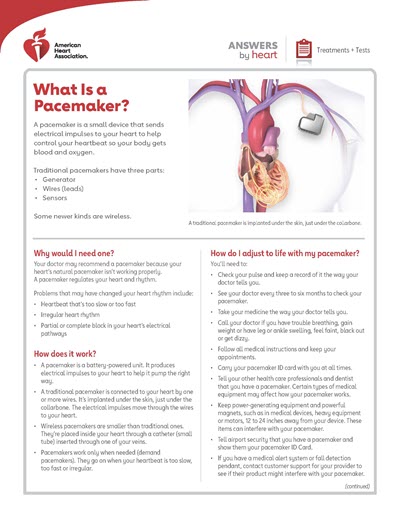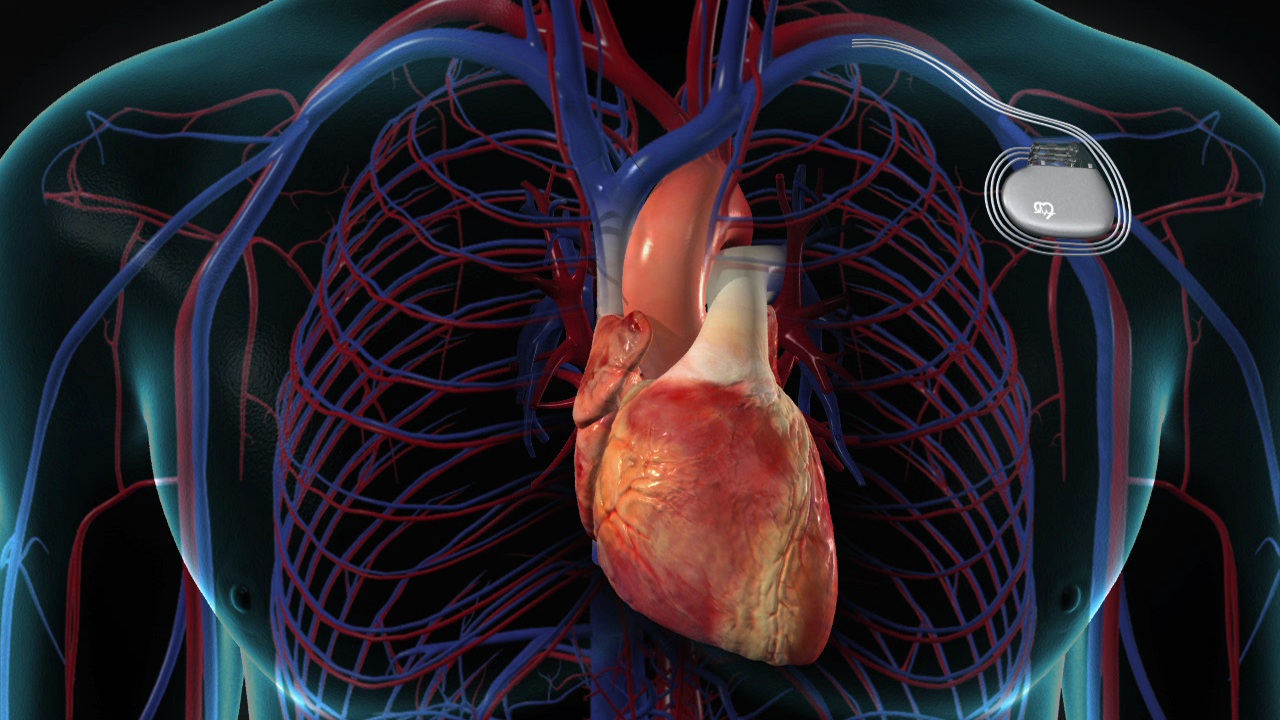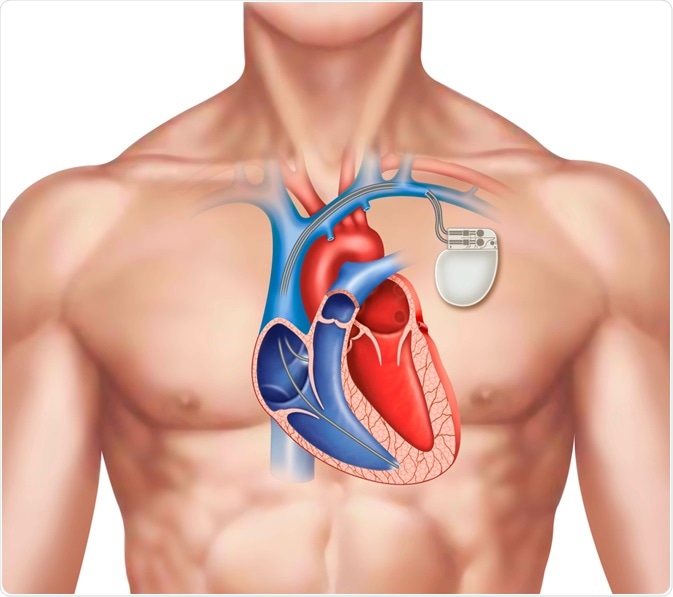Describe the Function of the Pacemaker
Right atrium right ventricle right auricle left auricle left atrium left ventricle pulmonary trunk. Pacemakers send electrical pulses to help your heart beat at a normal rate and rhythm.

Placement Of Pacemaker S Probes Inside A Human Heart Download Scientific Diagram
The main function of the SA node is to act as the normal pacemaker of the heart.

. A pacemaker is an electric medical device thats generally about the size of a matchbox. Your pacemaker also stores information about your heart. They generate the potentials.
Ventricular dyssynchrony is a common term used to describe this abnormal pumping pattern. Plasm ahs 9 View the full answer. Pacemakers are used to treat arrhythmias ah-RITH-me-ahs.
Solution for Describe the hearts pacemaker and internal electrical conduction system. Pacemaker codes were developed to describe cardiac pacemaker function. I kinda figured Advertisement Advertisement New questions in Health.
A pulse generator is a small metal case that contains electronic circuitry with a small computer and a battery that regulate the impulses sent to the heart. In the late 1700s Luigi Galvani discovered that he could cause contraction of a frog heart simply by passing an electrical current through the heart. The main function is to transport red blood cells.
Pacemakers are used to treat arrhythmias. Our heart and lungs are working all the time even when we are at rest. First week only 499.
The SA node generates a spontaneous pulse every time it contracts. The generator may be implanted under your skin through a small incision. The true beginning of the concept of a pacemaker began over 200 years ago.
Pacemaker cells depolarize more slowly than surrounding contractile cells because they do not have voltage-gated sodium ion channels in their sarcolemmae. A generator and wires leads. The human body performs various functions with the coordination of several systems.
Helps with atrial filling helps reduce friction protects heart. What is the function of the pacemaker. This pulse causes atrial muscles to.
It initiates an action potential that results in an electrical impulse traveling through the hearts electrical conduction system to cause myocardial contraction. This allows your doctor to better evaluate the therapy and adjust your pacemaker settings if necessary. This device uses electrical pulses to prompt the heart to beat at a normal rate.
The slow initial depolarization phase of a pacemaker cell begins when nonspecific ion channels allow more sodium ions to leak into the cell than potassium ions can leak out leading to threshold. A surgeon implants it under your skin to help manage irregular heartbeats called arrhythmias. The SA node is thought to be the hearts pacemaker.
What is a pacemaker. Arrhythmias are problems with the rate or rhythm of the heartbeat. Arrhythmias are problems with the rate or rhythm of the heartbeat.
Familiarity with these codes is essential for nurses caring for the patient with a permanent pacemaker. The pacemaker continuously monitors your heartbeat and delivers electrical energy as programmed by your physician to pace your heart if its beating too slowly. What is the function of the pacemaker.
This device uses low-energy electrical pulses to prompt the heart to beat at a normal rate. Pacemakers can also be used to help your heart chambers beat in sync so your heart can pump blood more efficiently to your body. Compare the superficial features of the anterior and posterior aspects of the heart.
Start your trial now. When this happens less blood is pumped by the heart. The function of a pacemaker is to control the heart beat it is used in people who are prone to have an arrhythmic heart beat.
This may be needed if you have heart failure. It is located near the bottom of the heart behind the right side of the liver and below the diaphragm. There are two parts.
Describe the Function of the Following. A pacemaker is a small device thats placed in the chest or abdomen to help control abnormal heart rhythms. Blood- Blood is a mixture of plasma with different blood cells like RBCRed blood cells WBCWhite blood cells and platelets with plasma proteins like albumin globulin and coagulation factors.
A pacemaker signals the heart to beat when the heartbeat is too slow or irregular. Describe the function and location of pacemaker cells Pacemaker cells have a leaky cell membrane from sodium channels. You may need a temporary short-term or permanent long-term pacemaker.
Unlike atrial and ventricular cells pacemaker cells in the sinus node do not have a resting phase. These cells are found in the SAN. This concept was further realized nearly 100 years later with the first successful resuscitation of a child by Guilliame de Boulogne utilizing electricity.
A biventricular pacemaker paces both ventricles at the same time increasing the amount of blood pumped by the heart. The function of a pacemaker is to control the heart beat it is used in people who are prone to have an arrhythmic heart beat. A small battery-operated device that helps the heart beat in a regular rhythm.
The article addresses the classification code of the North American Society of Pacing and Electrophysiology and the British Pacing and Electrophysiology Group and its. A pacemaker is a small device thats placed in the chest or abdomen to help control abnormal heart rhythms. Give the difference between skeletal and cardiac muscle in terms of electrical impulses Main components of the cardiac muscle are same as skeletal.
It produces the electrical impulses that stimulate your heart to beat. As these devices contain magnets and thus may affect the function or programming. The generator is a small battery-powered unit.

Action Potentials In Pacemaker Cells Osmosis

Components And Construction Of A Pacemaker Ecg Echo

Detecting And Distinguishing Cardiac Pacing Artifacts Analog Devices

Arrhythmias Johns Hopkins Medicine Health Library Heart Electrical Coronary Arteries Coronary Artery Disease
.ashx)
Pacemaker Insertion Johns Hopkins Medicine

Implantable Medical Devices American Heart Association

Pin Auf Pathophysiology Heart Infarction
.ashx)
Pacemaker Insertion Johns Hopkins Medicine

Pacemaker Modes And Settings Youtube

Pacemaker Insertion Johns Hopkins Medicine

Cardiac Resynchronization Therapy Cardiac Family Nurse Practitioner Marketing

Pacemaker Therapy 1 Clinical Indications Placement And Complications Nursing Times






Comments
Post a Comment